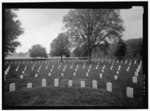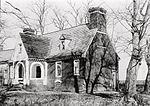The Battle of Malvern Hill, also known as the Battle of Poindexter's Farm, was fought on July 1, 1862, between the Confederate Army of Northern Virginia, led by Gen. Robert E. Lee, and the Union Army of the Potomac under Maj. Gen. George B. McClellan. It was the final battle of the Seven Days Battles during the American Civil War, taking place on a 130-foot (40 m) elevation of land known as Malvern Hill, near the Confederate capital of Richmond, Virginia and just one mile (1.6 km) from the James River. Including inactive reserves, more than fifty thousand soldiers from each side took part, using more than two hundred pieces of artillery and three warships.
The Seven Days Battles were the climax of the Peninsula Campaign, during which McClellan's Army of the Potomac sailed around the Confederate lines, landed at the tip of the Virginia Peninsula, southeast of Richmond, and struck inland towards the Confederate capital. Confederate general Joseph E. Johnston fended off McClellan's repeated attempts to take the city, slowing Union progress on the peninsula to a crawl. When Johnston was wounded, Lee took command and launched a series of counterattacks, collectively called the Seven Days Battles. These attacks culminated in the action on Malvern Hill.
The Union's V Corps, commanded by Brig. Gen. Fitz John Porter, took up positions on the hill on June 30. McClellan was not present for the initial exchanges of the battle, having boarded the ironclad USS Galena and sailed down the James River to inspect Harrison's Landing, where he intended to locate the base for his army. Confederate preparations were hindered by several mishaps. Bad maps and faulty guides caused Confederate Maj. Gen. John Magruder to be late for the battle, an excess of caution delayed Maj. Gen. Benjamin Huger, and Maj. Gen. Stonewall Jackson had problems collecting the Confederate artillery.
The battle occurred in stages: an initial exchange of artillery fire, a minor charge by Confederate Brig. Gen. Lewis Armistead, and three successive waves of Confederate infantry charges triggered by unclear orders from Lee and the actions of Maj. Gens. Magruder and D. H. Hill, respectively. In each phase, the effectiveness of the Federal artillery was the deciding factor, repulsing attack after attack, resulting in a tactical Union victory. In the course of four hours, a series of blunders in planning and communication had caused Lee's forces to launch three failed frontal infantry assaults across hundreds of yards of open ground, unsupported by Confederate artillery, charging toward firmly entrenched Union infantry and artillery defenses. These errors provided Union forces with an opportunity to inflict heavy casualties.
Despite the Union army's victory, the battle did little to alter the outcome of the Peninsula Campaign: after the battle, McClellan and his forces withdrew from Malvern Hill to Harrison's Landing, where he remained until August 16. His plan to capture Richmond had been thwarted. The Confederate press heralded Lee as the savior of Richmond. In stark contrast, McClellan was accused of being absent from the battlefield, a harsh criticism that haunted him when he ran for president in 1864.








